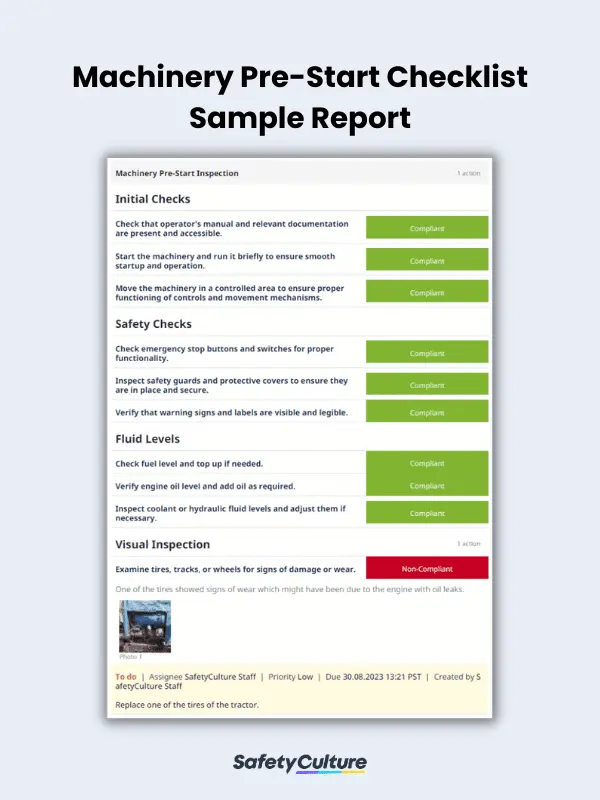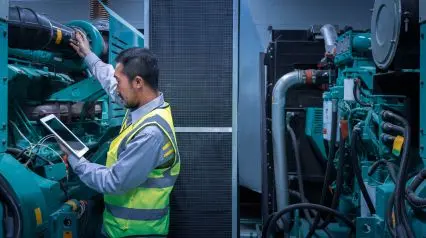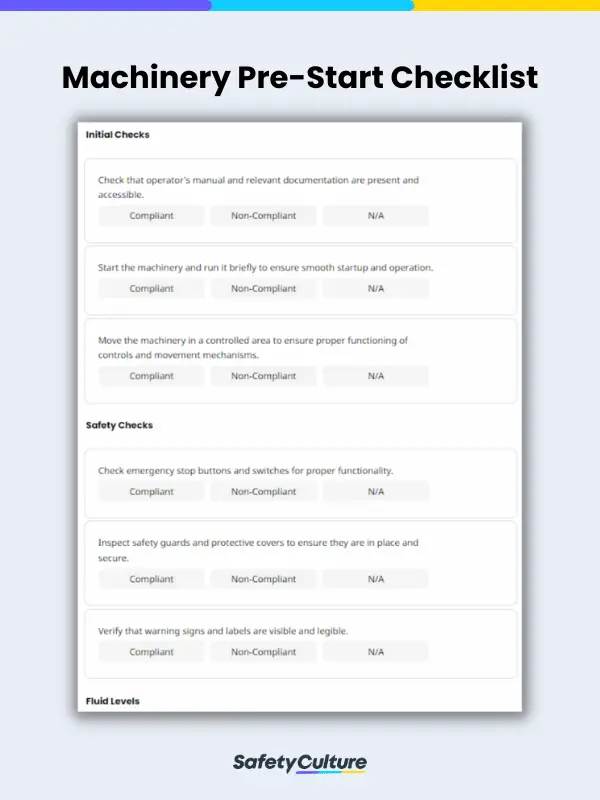What is a Machinery Pre Start Checklist?
A machinery pre-start checklist is a systematic and comprehensive tool that lists a range of tasks and items that encompass safety measures, operational components, fluid levels, and visual inspections. These need to be checked and verified by operators, inspectors, and maintenance personnel before starting and operating any machinery to ensure that it’s in proper working condition and complies with safety standards.
Importance of a Pre Start Checklist for Machinery Safety
In industries where machinery plays a pivotal role, the safety of both operators and bystanders is of paramount importance. This is where the significance of pre-start checklists comes into play. Pre-start checklists serve as a vital safeguard, ensuring that machinery is not only functional but also adheres to stringent safety standards.
Hence, using one for machinery pre-start checks helps you perform and achieve the following:
Catch Issues Proactively
By meticulously going through the items on a pre-start checklist, operators and maintenance personnel can identify potential issues or discrepancies that might affect the machinery’s safe operation or efficiency. This proactive approach not only helps prevent accidents and ensure the well-being of operators and those in the vicinity but also contributes to minimizing unexpected downtime due to unforeseen problems.
Also, detecting issues at an early stage is pivotal in preventing minor problems from escalating into major malfunctions. Pre-start checklists prompt operators and maintenance personnel to assess machinery thoroughly, identifying any signs of wear, loose parts, or irregularities that might impact performance and safety.
Ensure Emergency Preparedness
Machinery pre-start checklists can cover items such as inspecting emergency stop buttons, ensuring protective guards are in place, verifying proper fluid levels (such as fuel, oil, and coolant), examining tires or tracks, and checking for any visible wear and tear or loose components. This way, mishaps that could lead to injuries or even fatalities can be avoided.
On another note, industries governed by strict safety regulations require adherence to specific standards. Pre-start checklists ensure that machinery meets these regulatory requirements, shielding companies from legal liabilities and penalties while fostering a culture of responsibility.
Improve Machinery Inspection Process
Machinery pre-start checklists cultivate a standardized approach to safety. They help ensure that all operators follow the same set of safety measures and protocols, irrespective of their experience levels, reducing the likelihood of human error.
Another important thing to note is that well-executed machinery pre-start inspections using checklists improve operators’ confidence in the safety and reliability of their machinery. This leads to better task accomplishment and overall job performance.
What Should Be Included in a Machinery Pre Start Checklist
Since a machinery pre-start checklist aims to ensure the safety, functionality, and efficiency of the equipment, it should cover a range of critical items and tasks that need to be inspected and verified before initiating the operation of the machinery. These include the following:
- Initial Checks (Documentation, Start-Up Test, Test Movement)
- Safety Checks
- Fluid Levels
- Visual Inspection
- Operating Systems
- Lubrication
- Attachments and Implements
- Brakes and Parking Mechanism
- Fluid Contamination
- Battery and Electrical Systems
- Safety Equipment
- Operator’s Cabin
How to Create One
Creating a thorough and effective machinery pre-start checklist involves a thorough consideration of the specific machinery or equipment you’re working with, as well as the applicable industry standards and regulations.
To guide you, you can follow these steps to create a checklist you can use when conducting machinery pre-start inspections:
- Refer to the manufacturer’s manual, guidelines, and recommendations for the machinery to gain insights into essential maintenance points and safety measures.
- Break down the machinery into its critical components, systems, and parts so that each component can be inspected for safety and functionality.
- Familiarize yourself with industry safety standards and regulations applicable to the machinery to ensure your checklist aligns with the required safety measures.
- Collaborate with experienced operators, maintenance personnel, and safety experts by heeding their insights on identifying specific issues and concerns to be addressed using the checklist.
- Group checklist items based on categories and create specific checklist items that cover all aspects of the machinery and outline the tasks to be performed. Make sure to place safety-related items at the top of the checklist.
- Use clear and concise language to ensure that anyone using the checklist can understand and perform the tasks without ambiguity.
Best Practices for Machinery Pre Start Checklist Implementation
Standardizing and implementing the use of a machinery pre-start checklist in an organization requires careful planning, consistent execution, and a commitment to safety and maintenance.
To help you make this possible, heed these best practices to ensure the successful implementation of pre-start checklists for machinery inspections and operation:
- Develop clear and comprehensive checklists.
- Involve relevant stakeholders.
- Provide clear instructions.
- Prioritize safety checks.
- Schedule regular check-ups.
- Include visual inspections.
- Consider using digital tools or software to create, manage, and share checklists and streamline recordkeeping.
- Train operators and maintenance personnel on how to use the checklist effectively.
- Maintain a record of completed pre-start checklists that will serve as valuable documentation for audits, inspections, and maintenance history.
- Foster a culture of continuous improvement by seeking input from personnel and regularly evaluating the effectiveness of the checklist process.
- Establish a routine schedule for completing pre-start checklists. Ideally, they should be completed before every use of the machinery.

Machinery Pre-Start Checklist Sample Report | SafetyCulture
FAQs About Machinery Pre Start Checklists
While there’s no universal legal requirement for the use of machinery pre-start checklists, some industries and organizations may require them as part of their safety and operational protocols.
For example, the construction, mining, manufacturing, agriculture, and transportation industries often have strict safety requirements due to the inherent risks associated with heavy machinery operations. Sectors and organizations in these industries may then have internal policies and procedures that require the use of such checklists.
Yes, these tools can indeed help businesses and organizations extend the lifespan of their machinery. Regularly conducting thorough pre-start inspections and following proper maintenance procedures contribute to the longevity of equipment in various ways:
- Early Issue Detection
- Preventive Maintenance
- Optimal Performance
- Reduced Wear and Tear
- Improved Resale Value
- Catastrophic Failure Avoidance
- Compliance with Manufacturer Guidelines
- Safety Considerations
- Cost Savings
When conducting pre-start checks on excavators, it’s important to thoroughly assess various components to ensure the equipment’s safety, functionality, and efficiency. Here’s a breakdown of the pre-start checks you should perform on excavators:
- Visual Inspection
- Safety Features and Equipment
- Fluid Levels
- Hydraulic System
- Attachments
- Operator’s Cabin
- Lights and Signals
- Controls
- Brakes and Parking Mechanism
- Lubrication
- Battery and Electrical Systems
- Engine Start-Up
- Movement Test



